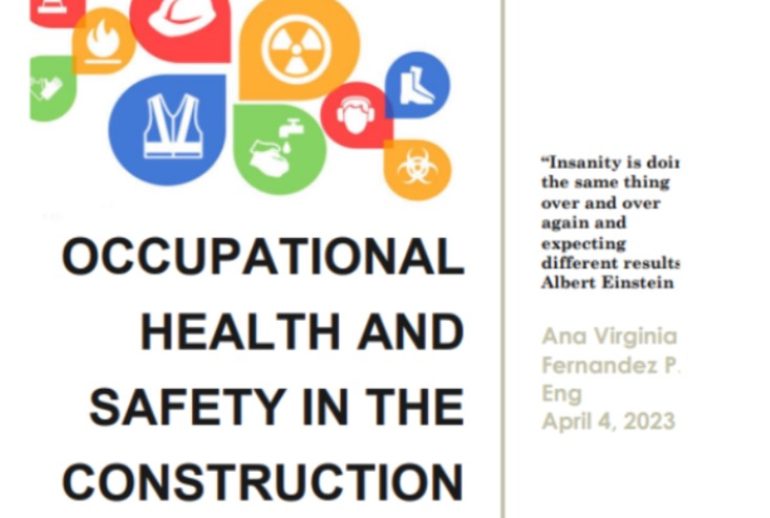Why implement an Occupational Health and Safety system in construction projects?

Occupational health and safety (OHS) in the construction sector refers to the policies, practices, and regulations aimed at protecting the health, safety, and well-being of workers employed in construction activities. Construction work involves various hazards and risks, such as working at heights, operating heavy machinery, exposure to harmful substances, electrical hazards, and more. The primary goal of occupational health and safety in construction is to prevent accidents, injuries, and illnesses by implementing proactive measures and ensuring compliance with safety standards.
Here are some key aspects of occupational health and safety in the construction sector:
- Risk assessment: Identifying and assessing potential hazards and risks associated with construction activities, including site-specific risks, machinery, tools, materials, and working conditions.
- Safety policies and procedures: Developing and implementing comprehensive safety policies and procedures that outline safe work practices, emergency protocols, personal protective equipment (PPE) requirements, and other safety guidelines.
- Training and education: Providing adequate training and education to construction workers, supervisors, and managers on safety protocols, hazard identification, proper equipment usage, and emergency response procedures.
- Regulatory compliance: Ensuring compliance with relevant occupational health and safety regulations, standards, and codes of practice established by government authorities or industry bodies.
- Hazard control measures: Implementing measures to control and minimize identified hazards, such as engineering controls (e.g., safety barriers, ventilation systems), administrative controls (e.g., work permits, signage), and personal protective equipment (e.g., hard hats, safety harnesses).
- Site inspections and audits: Conduct regular inspections and audits to identify potential hazards, assess compliance with safety regulations, and address any deficiencies promptly.
- Incident reporting and investigation: Establishing a system for reporting and investigating accidents, near misses, and work-related incidents to determine root causes, implement corrective actions, and prevent future occurrences.
- Health and wellness programs: Promoting employee well-being by offering health and wellness programs, providing access to medical services, and addressing physical and mental health concerns.
- Collaboration and communication: Encouraging open communication and collaboration between workers, supervisors, contractors, and management to foster a positive safety culture, share safety information, and address concerns effectively.
- Continuous improvement: Regularly reviewing and improving occupational health and safety practices through feedback, data analysis, and implementing lessons learned from previous incidents.
By prioritizing occupational health and safety in the construction sector, organizations can create safer work environments, reduce workplace injuries and illnesses, improve productivity, and protect the well-being of their workers.
Implementing an occupational health and safety (OHS) system in construction offers several significant benefits. Here are some key advantages:
- Worker Safety and Well-being: The primary benefit of an OHS system is the protection of workers’ safety and well-being. By identifying and mitigating hazards, providing proper training, and enforcing safety protocols, the system helps prevent accidents, injuries, and illnesses among construction workers. This creates a safer working environment and reduces the human and financial costs associated with workplace incidents.
- Reduced Accident and Injury Rates: An effective OHS system helps decrease accident and injury rates in construction. By implementing proactive measures and safety controls, such as hazard identification, risk assessments, and the use of personal protective equipment, the likelihood of incidents occurring is significantly reduced. This leads to fewer workplace accidents, resulting in lower injury rates and related costs.
- Compliance with Regulations: The construction industry is subject to numerous occupational health and safety regulations and standards. Implementing an OHS system ensures compliance with these requirements, helping construction companies avoid penalties, fines, legal liabilities, and potential damage to their reputation. It also demonstrates a commitment to the well-being of workers and responsible business practices.
- Improved Productivity and Efficiency: A well-designed OHS system enhances productivity and efficiency in construction works. When workers feel safe and secure in their environment, they can focus on their tasks without unnecessary distractions or concerns. By reducing accidents, injuries, and associated downtime, projects can progress smoothly, meeting deadlines and reducing the risk of costly delays.
- Cost Savings: Implementing an OHS system can lead to significant cost savings. By preventing accidents and injuries, companies can avoid expenses related to medical treatment, worker compensation claims, insurance premiums, legal fees, and lost productivity due to absenteeism or disability. Additionally, by proactively addressing hazards and risks, the need for costly corrective actions or rework is minimized.
- Enhanced Reputation and Client Confidence: A strong OHS system demonstrates a commitment to worker safety and care, enhancing a company’s reputation and client confidence. Clients are more likely to choose contractors or construction firms with a proven track record of prioritizing occupational health and safety. This can lead to increased business opportunities, repeat clients, and positive word-of-mouth referrals.
- Improved Employee Morale and Retention: A safe and healthy work environment fosters positive employee morale and job satisfaction. When workers feel valued and protected, they are more likely to be engaged, motivated, and loyal to their employers. By prioritizing their well-being, companies can attract and retain skilled workers, reduce turnover, and create a positive work culture.
- Continual Improvement and Innovation: An OHS system promotes a culture of continuous improvement and innovation. By regularly reviewing incidents, near misses, and safety practices, companies can identify areas for improvement and implement proactive measures to prevent future incidents. This leads to ongoing learning, innovation in safety practices, and the development of best practices within the construction industry.
verall, implementing an OHS system in construction works is essential for protecting workers, ensuring compliance, improving productivity, reducing costs, and enhancing a company’s reputation. It creates a safer, healthier, and more efficient working environment, benefiting both the workforce and the organization.
All of us who have sought and found construction jobs are concerned that the job is safe and that the conditions on the site are not harmful to our lives or health.
In this context, at STADT Studio we have developed a Guide to Good Occupational Health and Safety Practices for the Construction Sector in Belize. This can be requested by sending an email.

Lorem ipsum dolor sit amet, consectetur adipisicing elit, sed do eiusmod tempor incididunt ut labore et dolore magna aliqua.
